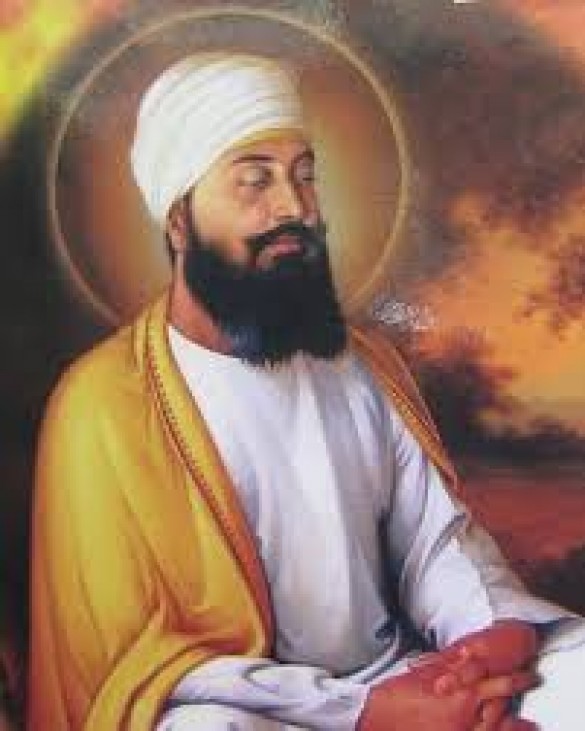
Guru Tegh Bahadur Ji was the ninth of the ten guru of Sikhism. He followed the steps of his grand-nephew and the eighth guru Sir Suru Harkrishan Ji. Guru Tegh Bahadur Ji, a poet, philosopher, and warrior, carried on the holiness and divinity of Guru Nanak Dev Ji and the succeeding Sikh Gurus. His spiritual writings, which cover a range of subjects including the nature of God, human relationships, the body, mind, sorrow, dignity, service, death, and deliverance, are preserved in the Sri Guru Granth Sahib Ji as 116 poetic poems.
To spread the message of Sikhism, the Guru traveled extensively through the Indian subcontinent, setting up several new preaching centers. He founded the town of Chak-Nanki in Punjab, later enlarged by the tenth Nanak, Guru Gobind Singh Ji, into the city of Sri Anandpur Sahib.
Also read: Guru Harkrishan Sahib Ji: Bal Guru
Hindu Pandits from the Kashmir region addressed Guru Tegh Bahadur Ji in May 1675, asking for the Guru's help in stopping the Mughal rulers of India from forcing Hindus to convert to Islam. On the command of Emperor Aurangzeb, Guru Teg Bahadur Ji was publicly beheaded in the imperial capital of Delhi for his support of the Hindu Pandits in opposing these forced conversions and for refusing to convert to Islam himself.
Originally known as Tyag Mal (Master of Renunciation), Guru Ji grew up in Amritsar. In his formative years, Bhai Gurdas taught him Gurmukhi, Hindi, Sanskrit, and Indian religious philosophy; Baba Budha taught him horseback and archery; and his father, Guru Hargobind Ji, Master of Miri and Piri, taught him swordsmanship. When he was just 13 years old, he begged his father to fight beside him as Painde Khan and the Mughals attacked his town during a conflict over Shah Jahan's hawk. He had freely charged the adversaries during the conflict, slicing his sword to the left and right.
Also read: Guru Granth Sahib: The Holy Book
The Sikhs who had won the battle (the Battle of Kartarpur) gave their new hero a new "warriors" moniker when they returned home. Tyag Mal Ji was changed to Tegh Bahadur Ji, which means "brave sword wielder" or "best sword wielder," respectively. (Tegh means a swordsman. At that time, the word bahadur, which originally meant valiant, was also employed as a superlative to denote superior or best. The youthful Tegh Bahadur soon displayed a leaning towards the preceding Sikh Gurus who had transmitted the sacred headdress of renunciation, known as the "sell" of Nanak, to each new Guru. Living true to his given name, Master of Renunciation, he immersed himself in his studies and spent his time in meditation. At Kartarpur, he married Mata Gujri Ji in 1632.
Guru Hargobind reportedly began preparing his grandson Har Rai to take Guru Nanak's seat after his son Bhai Gurditta's untimely death. In 1644, Har Rai Ji succeeded Guru Hargobind. Shortly after, Tegh Bahadur Ji was instructed by Guru Hargobind to relocate to the village of Bakala with his mother, wife, and wife. He had promised his wife that one day he would become Guru, have a son and that both would become famous in their battle for justice. His wife had wanted her son to follow the father as Guru.
Also read: Baba Banda Singh: Fearless And Undaunted Spirit
The Master of Renunciation spent most of the following 20 years engrossed in meditation in a subterranean room. Guru Har Krishan Ji said that his heir would be found in Bakala before he ascended to God's throne. A wealthy Sikh trader, Makhan Shah, whose ship was caught in a strong storm, had earlier prayed to God, promising to give his Guru Har Krishan 500 golden Mohurs if his ship made it to shore safely.
The ship safely landed, and the guy, a Sikh of great integrity, immediately set off towards Delhi, where the young Guru had journeyed under Aurangzeb's orders. He discovered along the journey that Guru Har Krishan had passed away and had mentioned that the village of Bakala was home to the next Guru. When he arrived in Bakala, he discovered 22 members of the Sodhi dynasty posing as the Guru and accepting money from Sikhs. The two gold pieces he chose to offer to each Guru were well received and blessed by everybody.
Also read: Guru Angad Dev Ji: Gurmukhi Script
Guru Tegh Bahadur was now in charge of training and directing the Sikh community. He served as the Sikhs' main object of adoration. They arrived both individually and in groups in search of spiritual comfort and motivation. And he shaped their religious and social conscience via his teachings and actions.
Guru Tegh Bahadur maintained an opulent lifestyle, as had been the norm since Guru Har Gobind. He was distinguished by his armed guard and other royal attributes. However, he personally led a simple life. There is no hint of a conflict with the reigning power in Sikh or other sources from his time.
Also read: Guru Harkrishan Sahib Ji: Visit in Delhi
Baba Deep Singh Ji: Head Granthi
Baba Banda Singh Bahadur : Joining Of Guru Gobind Singh Ji
Baba Banda Singh Bahadur: Arrest And Torture By Mughals